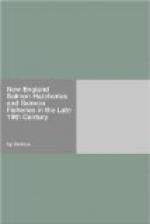I am sorry to say that I cannot report the catch of any S. quinnat, yet three fish have been sent in for the premium we held out for the first fifteen caught, but they proved not to be quinnat. Lately I heard that there were so many salmon caught in the Ourthe, near Liege, Belgium (the Ourthe is one of the feeders of the Maas), which was an astonishing fact, as salmon are seldom taken there.
Bergen op Zoom, Netherlands, January 12, 1884
ARTICLE IV
Memoranda relative to inclosures for the confinement of salmon drawn from experience at Bucksport, Penobscot river, Maine.
By Charles G. Atkins
[In response to request of Dr. C. J. Bottemanne.] April 7, 1884.
Bulletin of the United States Fish Commission, Vol. 4, Pages 170-174, 1884.
The Penobscot salmon-breeding establishment was founded in 1872, at Bucksport; in the State of Maine, near the mouth of the Penobscot River. The location was primarily determined by the necessity of being near a supply of living adult salmon, to be used for breeders.
After an exploration of the headwaters of the Penobscot, which lie mostly in an uninhabited wilderness, the conclusion was reached that the chances of securing a sufficient stock of breeders were much greater at the mouth of the river, where the principal salmon fisheries are located; but to avail ourselves of the supply here afforded we must take the salmon at the ordinary fishing season, May, June, and July, and keep them in confinement until the spawning season, which is here the last of October and first of November. As the salmon naturally pass this period of their lives in the upper parts of the rivers, it was thought essential to confine our captives in fresh water.
Later experiments in Canada indicate that they will do as well in salt water, but the construction and maintenance of inclosures is much easier when they are located above the reach of the tide, to say nothing of the proximity of suitable fresh water for the treatment of the eggs. In the precise location of the inclosures several changes have been made, but they have always been in fresh water, and within convenient distance (5 to 10 miles) of the place where the salmon were captured.
In our experiments and routine work we have made use of four inclosures, which I will now describe.
No. 1. In Craig’s Pond Brook, a very pure and transparent stream, an artificial pond 40 square rods in area and 7 feet in extreme depth, was formed by the erection of a dam. The bottom of this pond was mainly a grassy sod newly flooded. About half the water came from springs in the immediate vicinity, and the rest from a very pure lake half a mile distant. The water derived from the lake was thoroughly aerated by its passage over a steep rocky bed. The transparency of the water in the pond was so great that a pin could be seen at the depth of six feet.




